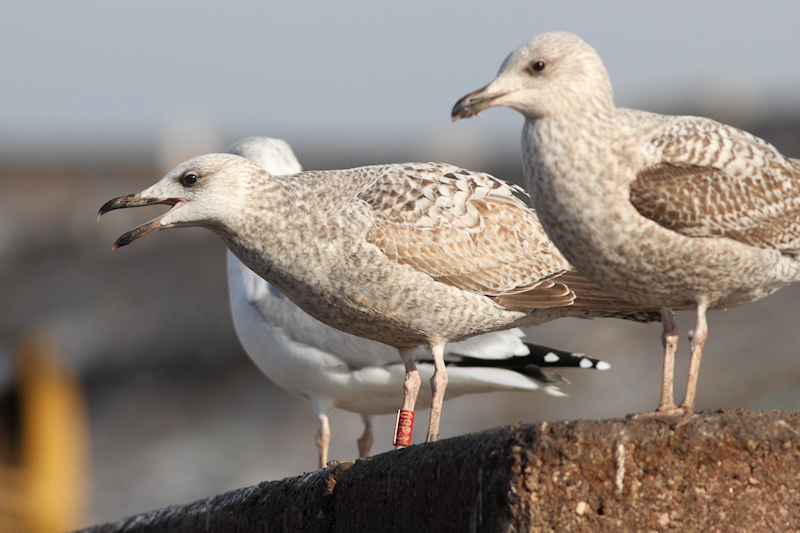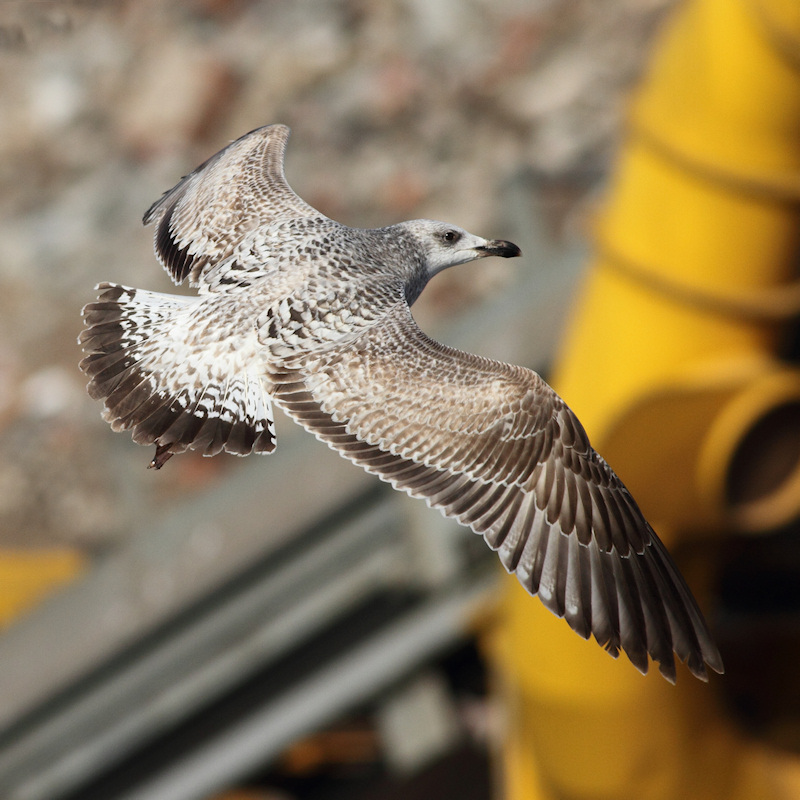 Larus cachinnans
Larus cachinnans
(last update:
Greg Neubauer
Marcin Przymencki
Albert de Jong
Mars Muusse
cachinnans plumages
Larus cachinnans hybrid 2CY 09P3 February 05 2015, Barneveld, the Netherlands. Picture: Albert de Jong.
Red ring from Poland used in 2014. 300 pulli were ringed this year, all pulli in May 2014 at the Kozielno colony, Paczkow, Poland, ringed by Jacek Betleja. See: ZB.KOZIELNO,PACZKÓW, POLAND (50°28'35.8''N 16°58'54.2''E).
Data:
2014 May 15 - Kozielno, Poland. Ringed as chick, metal PLG DN31109 and red 09P3.
2014 Oct 11 - IJmuiden, the Netherlands.
2015 Jan 29 - Barneveld, the Netherlands.
2015 Feb 05 - Barneveld, the Netherlands.
The Kozielno colony is in S poland, near the border with Czech Republic. It is not likely to find Herring Gull argentatus in this region, but mixed breeding with Yellow-legged Gull michahellis has been described: "The only known case of hybridisation outside regularly studied colonies comes from Lower Silesia, SW Poland. A single mixed pair Caspian x Yellow-legged Gull was recorded at the Nysa Reservoir in 2000-01 (STAWARCZYK & TOM1ALOJC 2003)." Nysa is the next large town close to Kozielno. In this area, import from mixed German colonies has been described as well.
This bird, red 09P3, is very Herring-like and has a score of 25 (rough estimations). Limited moult, transversal bars on scaps, even on very fresh lower scapulars, streaked head and mottled underparts, head shape with obvious gonys all indications for michahellis or argentatus influences.
Although obviously very much of hybrid, some influence of cachinnans apparent as well; like small eye, dark outerwebs of inner primaries (common in michahellis as well), absence of bulge and long looking legs.
To discuss such birds, its good to first classify it on the 'hybrid scale' according Gibbins et al, see table below pictures.
Interestingly, the bird has some vermiculated patterns on the innerwebs of the inner primaries.


Below, table 2 is repeated to score this bird. The scores are in italic + bold.
Overall score is 25, which places this bird in the outer limit of cachinnans but central in the hybrid zone of the spectrum (see figure 8, repeated below this table). Bill measurements and wing extension have a relatively high error as the image don't allow close details.
Table 2. Traits and scores used to characterise birds in first-winter plumage (October-March inclusive).
|
||
| Trait | Score | Description |
| Extent of scapular moult | 0 | no first-generation feathers remaining |
| 1 | a small number (<1/3) of first-generation feathers remaining | |
| 2 | a significant number (>1/3) of first-generation feathers remaining | |
| Greater-covert pattern | 0 | simple pattern with brown centres and sharp white edges, with no white vermiculation or notching |
| 1 | white edges with delicate notches or vermiculation; or dark brown centre with white tip to 1/3 of length (i.e. white restricted to tip or distal third) | |
| 2 | clear white notches / barring creating a delicate 'piano key' pattern along the whole edge / feather; but much of feather dark | |
| 3 | lots of white (more than 1/2 of coverts looking white) distributed along the whole feather, or a bold notching ('piano key' pattern) | |
| Bill shape | 0 | Very long and slim, no visible gonydeal angle (L:D ratio >2.8) |
| 1 | Slim, slight gonydeal angle (ratio 2.4-2.79) | |
| 2 | Intermediate (ratio 2.0-2.39) Rough estimation. | |
| 3 | Short and deep, well marked gonys angle (ratio <2) | |
| Leg length | 0 | Long and slim looking |
| 1 | Moderately long | |
| 2 | Short or short and stocky | |
| Ventral bulge | 0 | present |
| 1 | absent | |
| Primary projection | 0 | very long (ratio >0.6) |
| 1 | moderately long (ratio 0.5-0.59) Rough estimation. | |
| 2 | medium (ratio 0.4-0.49) | |
| 3 | short (ratio <0.4) | |
| Moult: greater coverts | 0 | all or almost all new (>75%) |
| 1 | 51-75% new | |
| 2 | 34-50% new | |
| 3 | 10-33% new | |
| 4 | one or two feathers moulted | |
| 5 | no moult | |
| Moult: median coverts | 0 | all or almost all new (>75%) |
| 1 | 51-75% new | |
| 2 | 34-50% new | |
| 3 | 10-33% new | |
| 4 | one or two feathers moulted | |
| 5 | no moult | |
| Moult: tertials | 0 | 3 or more new |
| 1 | 2 new | |
| 2 | 1 new | |
| 3 | all old | |
| Darkness of head and body | 0 | totally white |
| 1 | reduced grey wash or streaking (confined to flanks and/or single streaks around nape) | |
| 2 | light streaking/wash to head (incl. some dark around eye); isolated streaks/blotches on body. Overall, body looks more white than brown | |
| 3 | well streaked: dark mask around eye and/or streaking covering the whole head/face; body with extensive but moderately dense streaks/mottles | |
| 4 | strong and dense streaking/mottling on body and head making it appear almost wholly dark | |
| First-generation tertial pattern | 0 | diffuse white tip (like Common Gull Larus canus) |
| 1 | fine pale fringe around distal portion (like classic michahellis), possibly also with some vermiculations | |
| 2 | edges moderately notched | |
| 3 | edges strongly notched and/or some dark barring or pale patches across the feather on some or all tertials | |
| Second-generation scapular pattern | 0 | uniformly silvery-grey, darker patterning absent or very faint |
| 1 | silvery-grey background, pattern stronger than on 0, but lacks strong barring or central dark diamonds (only dark shafts and subtle anchors), with only a minority (one or two) of such feathers admixed | |
| 2 | strong, contrasting shaft-streaks, anchors and/or dark central diamonds, but these more patterned feathers are less than 1/2 of all; ground colour creamy or silvery-grey, possibly with some grey feathers mixed in | |
| 3 | strong pattern described in 2 on most (more than 1/2) of feathers, but possibly also one or two plain grey feathers or feathers with grey ground tone | |
| 4 | all feathers contrastingly patterned (with dark cross bars or diamonds), lacking plain grey feathers; feather centres buffy-brown | |
Fig. 8. Sum trait scores for first-winter Caspian Larus cachinnans and Herring Gulls L. argentatus, and hybrids. Scores are calculated by summing individual trait score values. The figure shows the percentage of individuals in the sample with a given sum value. Numbers in parentheses are the minimum and maximum values recorded.
